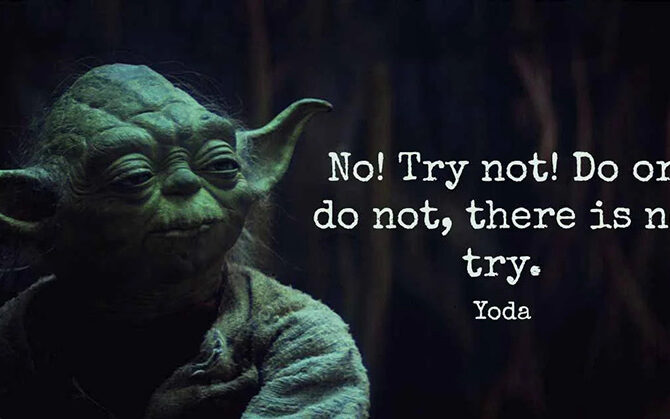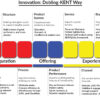
As a child, few movies captured my imagination quite like Star Wars. The sweeping visuals, the thrilling lightsaber duels, the mysterious worlds—it was a universe that felt limitless. But what truly stayed with me wasn’t just the adventure; it was the wisdom.
Among all these characters—Luke’s young bravery, Darth Vader’s menacing stature—my own was always Yoda. Small, green, and ancient, he was the epitome of unassailable strength. He did not speak much, but whatever he said, he said with the weight of centuries.
One sentence in particular has repeated itself in my mind for decades:
“Do or do not. There is no try.” — Yoda, The Empire Strikes Back
At face value, it’s a piece of advice anyone might give. But as I matured, I came to understand its multiple levels—teachings not only for individuals but leaders, experts, and whole organizations.
Why This Quote Resonates
Yoda’s phrase isn’t an exhortation to wild behavior. It’s talking about dedication. It’s about going at something whole hog, instead of going halfway with a half-hearted “I’ll try.”
How many times have we said, “I’ll try to make it,” or “I’ll try to do better”—when deep down we know our effort is conditional? “Trying” often becomes a linguistic shield for non-commitment.
In life, in relationships, in careers, and even in the development of nations, advancement occurs when we commit fully—not when we hesitantly get our feet wet.
An Ancient Indian Parallel – The Bhagavad Gita
This idea is not Yoda’s either. Bhagavad Gita’s Lord Krishna tells Arjuna:
“Yogasthaḥ kuru karmāṇi” – Be steadfast in yoga and then act. (Gita 2.48)
That is, get completely aligned and then carry out your duty without questioning anything. As Yoda urges Luke to give yourself to extracting the X-wing from the swamp completely, Krishna urges Arjuna to move into the battlefield with unshakeable determination.
A Modern Parable – The Bridge Builder
There’s a leadership legend about two men who are given the task of building a bridge. The first says, “I’ll try.” He paces off a bit, labours some, then quits when the labour is strenuous. The second says, “I will construct it.” He encounters problems, adjusts, and ends up building the bridge.
In the end, only a single man performed—and it wasn’t the “trying” one.
This reflects scores of everyday projects—in Indian startups, government projects, or worldwide technology startups—whereby half-hearted attempts are followed by half-done outputs.
Examples from the Indian Context
• ISRO’s Mars Mission (Mangalyaan) – When India set out to reach Mars on its first attempt with a fraction of NASA’s budget, the world watched with curiosity—and skepticism. If ISRO had approached it with “We’ll try,” the mission would never have been greenlit. Instead, they went all in—and succeeded, making India the first Asian country to reach Mars orbit.
• The Polio Eradication Drive – India needed to overcome one of the strongest public health barriers of the world in wiping out polio. No “trying” was permissible. It needed tireless vaccination efforts, massive volunteer action, and complete devotion—until success was won.
International Lessons
• Apple’s Initial iPhone – Steve Jobs famously claimed, “We don’t ship junk.” The iPhone did not come to market until Apple had pledged itself to an object that would redefine an industry. If they “attempted” to introduce something and then “fixed” it afterwards, the market may have written it off.
• The Moon Landing – In 1961, John F. Kennedy didn’t say, “We will try to go to the Moon.” He said, “We choose to go to the Moon in this decade.” That clear, unwavering intent galvanised a nation.
Psychology of “Do” vs. “Try”
Psychologists comment that “trying” has a tendency to give an intellectual escape route. It silently tells our thinking failure is acceptable. “Doing” frames the task as inevitable—invoking concentration, originality, and perseverance.
As Indian industrialist Ratan Tata says:
“I don’t believe in taking right decisions. I take decisions and then make them right.”
This is pure “Do or do not” thinking.
When ‘Trying’ Means a Coded Hiding of Fear
More often than not, “I’ll try” hides an underlying fear—fear of failure, of being judged, or of the unknown. In The Empire Strikes Back, Luke procrastinates before extracting the X-wing from the swamp. It’s Yoda’s moment to show belief precedes capability.
In life, fear looks like procrastination, elaborate plans, or constant “pilot projects” in organizations. When we talk about embracing digital health technology by Indian hospitals or deploying climate projects globally, success requires breaking the line from effort to action.
Balancing Boldness with Wisdom
Now, acting fully does not equate to acting blindly. As well, Yoda’s teaching and Indian spiritual traditions emphasize awareness before acting.
• Here, it would be doing research before investment, and then investing fully.
• In development, it means doing a single skill exceptionally rather than tinkering in multiple skills.
• In healthcare, this means doing more than launching telemedicine services but assuring training, infrastructure, and policy support.
Three Techniques to Practice Yoda’s Teaching
- Eliminate “Try” from Your Repertoire – Substitute with definitive language: “I will,” “I decide to,” “I make a commitment to.”
2. Visualise the End State – Like ISRO engineers picturing the Mars Orbiter in orbit, see your goal as already achieved.
3. Be Busy Pretending You Have No Choice but to Succeed – Commit resources, time, and focus commensurate with the importance of your objective.
Closing Thought
Whether you are a student preparing for exams, a doctor implementing a new treatment protocol, a startup founder chasing your first million customers, or a parent nurturing a child’s dream, the principle is universal:
Do, or do not. There is no try.
In a galaxy far, far away, this was Jedi training. Here on Earth, it’s life training. Indian cricket team did not “try” to win the 2011 Cricket World Cup. They played to win. Elon Musk did not “try” to create rockets that were re-usable—that’s why they repeatedly exploded. Yoda’s insight puts forth the understanding that commitment alters the vibration surrounding an intention. When you commit to “do” something, the mind ceases to argue and begins to create. And maybe when we reflect back on our own life’s adventures, we’ll realize our proudest moments are not the times we “tried”–but the times when we did.
Dr. Prahlada N.B
MBBS (JJMMC), MS (PGIMER, Chandigarh).
MBA in Healthcare & Hospital Management (BITS, Pilani),
Postgraduate Certificate in Technology Leadership and Innovation (MIT, USA)
Executive Programme in Strategic Management (IIM, Lucknow)
Senior Management Programme in Healthcare Management (IIM, Kozhikode)
Advanced Certificate in AI for Digital Health and Imaging Program (IISc, Bengaluru).
Senior Professor and former Head,
Department of ENT-Head & Neck Surgery, Skull Base Surgery, Cochlear Implant Surgery.
Basaveshwara Medical College & Hospital, Chitradurga, Karnataka, India.
My Vision: I don’t want to be a genius. I want to be a person with a bundle of experience.
My Mission: Help others achieve their life’s objectives in my presence or absence!
My Values: Creating value for others.
Feature Image Courtesy: Maja Sevic
Leave a reply
















*Dear Prahlada N. B Sir,*
Your article on "Do or Do Not. There Is No Try" resonated deeply, echoing the wisdom of Yoda that transcends the Star Wars universe and speaks directly to the human experience. The distinction between "trying" and "doing" is profound, and I'd like to highlight this difference using anecdotes, similes, and analogies.
*The Power of Commitment*
When we say "I'll try," it's often a veiled commitment, leaving room for escape. In contrast, "I will" or "I do" signifies a resolute commitment, akin to signing a contract with oneself. This mindset shift is crucial, as it alters our approach from hesitant to determined. For instance, ISRO's Mars Mission (Mangalyaan) exemplifies this "do or do not" approach, where unwavering dedication led to unprecedented success.
*Trying vs. Doing: A Bridge Building Parable*
The parable of two men tasked with building a bridge illustrates this point beautifully. The first man says, "I'll try," and his efforts are half-hearted, whereas the second man commits fully, saying, "I will construct it." The outcome is starkly different, with only the latter succeeding. This story mirrors many real-world projects where half-hearted attempts yield subpar results.
*The Psychology of "Do" vs. "Try"*
Psychologists note that "trying" provides an intellectual escape route, silently accepting failure as an option. In contrast, "doing" frames the task as inevitable, invoking focus, creativity, and perseverance. This mindset is reflected in Ratan Tata's words, "I don't believe in taking right decisions. I take decisions and then make them right." This approach embodies the "do or do not" philosophy, where commitment and action drive success.
*Applying Yoda's Wisdom in Life*
To incorporate this wisdom into our lives, we can :
– *Eliminate "Try" from Our Vocabulary*: Replace "try" with definitive language, such as "I will" or "I commit to."
– *Visualize the End State*: Envision our goals as already achieved, like ISRO engineers picturing the Mars Orbiter in orbit.
– *Act with Unwavering Commitment*: Commit resources, time, and focus commensurate with the importance of our objectives.
By embracing this mindset, we can transform our approach to challenges, moving from hesitant attempts to resolute action. Thank you for sharing your insights, Sir.
Reply